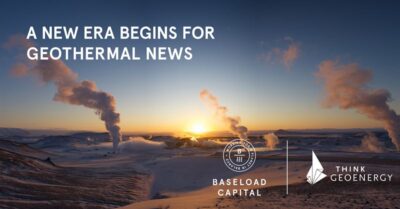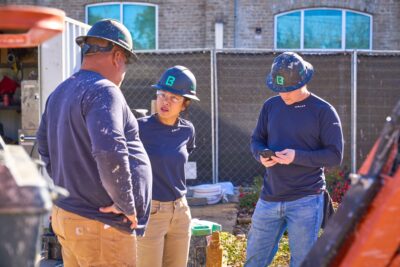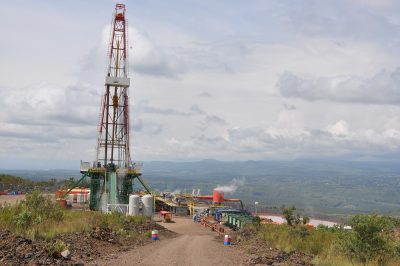Davenport Power planning temperature gradient drilling at Newberry, Oregon
Davenport Power is currently planning to continue exploration at its Newberry project with narrow temperature gradient wells that reach about 3,500 feet below the surface.
Reported locally, Davenport Power is currently planning to continue exploration at its Newberry project in Oregon. After drilling two exploratory wells 10,000 feet below the flanks of Newberry Volcano searching for hot rocks and water, the company found nothing but heat.
“Now the company, which hopes to tap into geothermal power in the Deschutes National Forest south of Bend, is making plans to use a suite of other less-intensive methods to further map the underground rocks and temperatures in the area to find other potential drill sites.
When crews bored two wells just to the west of Paulina Lake, outside of the Newberry National Volcanic Monument last year, instruments measured plenty of heat but not enough water or steam to turn turbines and generate power, said Doug Perry, president of Davenport Power.
The company hopes eventually to drill production wells that could fuel a power plant capable of providing electricity to about 100,000 homes.
But first, scientists will try to get a broader picture of the area’s geology, building on geologic mapping that other companies had done in previous years.
“One of the things we want to do is engage in some more exploration activity,” Perry said. “The idea is to still try to get the best picture we can of what it looks like down deep. Hopefully, from that we would end up targeting where we would drill some more exploratory wells.”
One way to get a better picture is with narrow temperature gradient wells that reach about 3,500 feet below the surface — an easier and cheaper procedure than the exploratory wells drilled in 2008. These temperature gradient holes can be drilled from the back of a truck, like a water well, Perry said, as opposed to the 180-foot-tall derricks needed to drill the exploratory wells.
Davenport plans to create a string of up to 12 temperature wells west of the monument to gauge the extent of the area’s hot rocks.
“We think that the area of heat may be larger than just the area where we were drilling those (exploratory) wells,” Perry said. “But we can do exploration and drill these temperature gradient wells a lot less expensively.”
There’s still no guarantee that a site will have water or steam, he said. The company would have to bring back the big drilling rigs later to test for that.
But the company also plans to try out a relatively new technology. Davenport plans to drop listening devices into the temperature gradient holes, Perry said, to see if they can pick up any background sounds that might be a hint of water moving through the ground.
“This is to try to hear if there’s any liquid moving,” Perry said.
Davenport also plans to conduct ground-level surveys, he said, continuing work geophysicists started in 2006. A gravity study could help tell scientists about the different rock layers, while a survey of changes in the magnetic field could help provide clues about the location of hot water.
“We’ve tried to come up with a program to hopefully give us additional and better information about what’s down there,” Perry said.
While Davenport is still hoping to find steam to fuel a power plant, he said the company is also considering using a technology called enhanced geothermal systems, or engineered geothermal systems.
In those systems, crews drill a well and create small fractures in the deep rock, then circulate fluid through the hot rocks. That way, they don’t need to find naturally occurring steam.
The technology created some controversy after a project set off a small earthquake in Europe.
Perry said the geology is different in Central Oregon, and if Davenport receives funding to try the enhanced geothermal technology, the company will do further analysis, reviewed by outside experts, to determine the local risk. The company would also have to get additional OKs from federal land management agencies.
For now, though, Davenport is focusing on the temperature wells and geophysical surveys.
The company still has to get permission from the Bureau of Land Management for the temperature wells. The agency is getting ready to start an environmental assessment of the potential impacts of the series of drill sites, said Linda Christian, environmental coordinator with the BLM’s Prineville District.
Davenport is proposing to do the work without building new roads or cutting down trees, she said, but will instead drill along existing forest roads and in previously clear-cut areas.
“The total area that’s going to be disturbed in this whole environmental assessment (area) is 2.5 acres, in 100-by-100-foot lots,” Christian said.
The work could damage some habitat, but once the company gathers data it will restore the area, she said.
And the information will help provide a better picture of the geology in the area, she said.
“We’re trying to get the science and figure out if this is a viable alternative energy source,” Christian said. “Maybe it won’t be, but they need to look at all avenues.”
Davenport Power’s attempts to find steam to fuel a power plant have yet to succeed. Now the company will use much smaller drills in hopes of finding the right site.”
Source: Bend Bulletin











